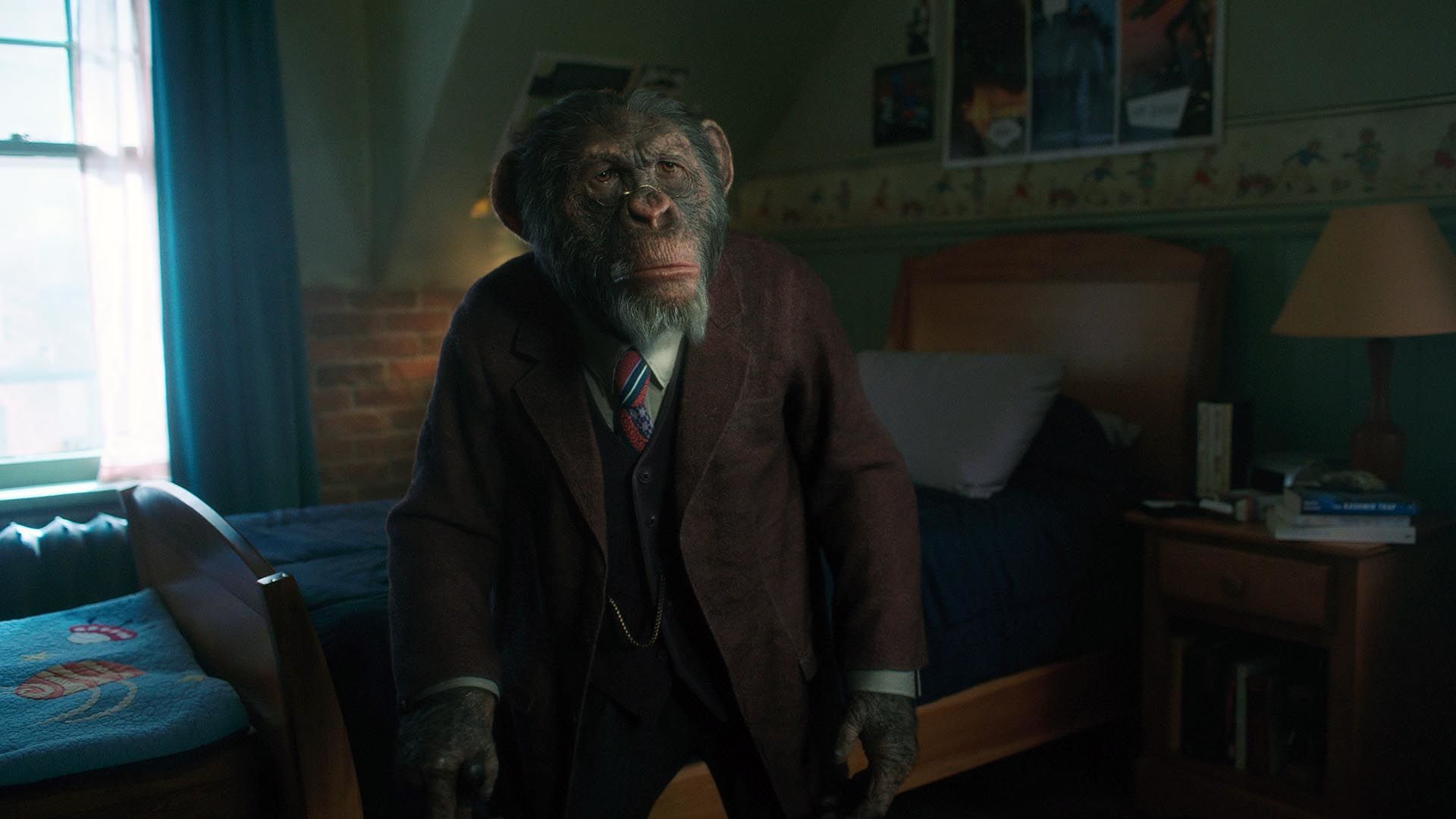Create a free profile to get unlimited access to exclusive videos, sweepstakes, and more!
Science Behind the Fiction: Could we make super-smart chimps like The Umbrella Academy's Pogo?

The world, as presented by The Umbrella Academy, is full of countless wonders. There is biologically enhanced astronauts, mind control, life after death, time travel, and knives that disregard the laws of physics, to name a few. So, when viewers are introduced to Pogo, a chimpanzee with enhanced intellect and a snazzy three-piece suit, they hardly bat an eye. Of course, there's a posh ape running the Academy. Why wouldn't there be?
And in the context of the show, or the graphic novels on which it's based, there is little cause to ask too many questions. Dr. Reginald Hargreeves, the Academy's founder, was a mad genius. He made a super smart chimp because he could, and that's the end of it.
Here, however, in the real world, there is some debate about whether or not humans should enhance the intelligence of non-human animals. Some stand firmly in the camp of leaving well enough alone and going about our business, leaving the rest of the animal kingdom to its own devices. Others believe not only that we should "uplift" our non-human cousins, but that we have a moral obligation to do so.
While this question was long one of pure speculation, recent advancements in genetics, computer technology, and neuroscience have allowed us to reach a point where that question might soon need a definitive answer. Some even believe that point might already be behind us.
THE CURRENT STATE OF COGNITIVE ENHANCEMENT
Understanding cognition is perhaps the problem of the scientific endeavor. Every other question is understanding a small part of the world around us, but cracking the mind is an attempt to understand how we perceive anything at all. It's no small undertaking, perhaps because it is the mind itself looking at itself in a mirror.
In order to make progress — and avoid some of the ethical problems inherent in research — scientists often look to non-human animals to glean clues. In a way, it's like looking at a map of a city because looking at the real thing would be too vast to fully comprehend.
If we can understand the inner workings of a worm, a mouse, or a monkey, it might get us a step closer to understanding ourselves. So when researchers attempt to solve problems of decaying cognition or enhancing humanity's innate abilities, that's where they turn, and sometimes we make some startling discoveries. Enter the FOXP2 gene.
The FOXP2 gene, so far as we understand, is a gene regulator that plays an important role in neuron transmission and has a specific role in speech and language in humans. It's a good marker for studying intelligence, which made it the perfect target for studies involving non-human species.
Data published by MIT explores FOXP2's function as it relates to intelligence. They did so by genetically engineering mice with the gene and studying the impact. By introducing this gene, Ann Graybiel and her colleagues were able to measurably increase the intelligence of the test mice. Those with the genetic modification were able to more easily form memories and solve a maze.
While this tells us something about our own evolution and the emergence of complex language, it also has implications within the uplift community. Introducing FOXP2 did not result in talking, sapient mice. But it is an incremental increase in mouse intelligence that suggests the possibility of further advancement.
Genetic modification is only one avenue researchers are exploring to increase animal intelligence.
Alexander Kotrschal, working in a Swedish lab, was able to increase brain size in guppies through selective breeding. It has long been suggested there is a correlation between increased brain size, relative to the body, and intelligence. Studying guppies might seem counterintuitive, as the likelihood of developing guppies with anything approaching human-level intelligence is next to nil, but it actually makes sense. Because of their relatively low natural intelligence, minimal improvements are easy to see. Kotrschal's research resulted in guppies with brain sizes 9 percent larger than their counterparts and the females in the test group were measurably better at completing an object discrimination task than their peers.
This increase in brain mass came at a cost, though, by way of decreased gut mass. What Kotrschal determined was that the biological scales must always be balanced, in order to feed one hand, we must take from another. Those individuals with increased brain mass also produced fewer offspring. This finding has particular implications for the evolution of intelligence. Those species moving toward higher intelligence by way of larger brains must balance that increase against the deficit of fewer children. In the midst of a genetic arms race, ten less-intelligent children is better than one brilliant one, so long as they survive to pass on their genes.
Perhaps the most compelling and bizarre example of minor uplift comes from research teams at Wake Forest Baptist Medical Centre, the University of Kentucky, and the University of Southern California. Their research, published in the Journal of Neural Engineering, outlines an account of an experiment involving rhesus monkeys completing a matching task.
The monkeys were shown images then, after a delay, had to select the image from an array of options. The involved animals had been previously trained for this task and maintained a success rate of 75 percent.
The experiment's goal was to simulate degenerative cognitive conditions, such as dementia or Alzheimer's, and explore potential treatments. Here's where things get several levels of weird. The researchers simulated cognitive degeneration by dosing the monkeys with cocaine. As expected, their ability to complete the test task decreased, at least until a neural device stimulated targeted neurons.
When stimulated by the device, the doped monkeys reclaimed their previous abilities. Furthermore, test monkeys who were not dosed with cocaine, and who had the use of the neural device, performed at higher than expected levels. The findings suggest not only that neural stimulation via synthetic technology can restore decreased cognitive function but that it can also increase the natural baseline.
In short, the uplifting of non-human animals to a small degree, through the use of technology, selective breeding, and genetic engineering, has already been achieved. Supposing a continued increase in these areas of research, it's reasonable to assume that the level to which we could increase brain function of humans and non-humans will continue to rise.
It's probably not time to put your simian tailor on speed dial just yet, as the reality of truly uplifted non-human animals is still off in the distance. But it might be time to decide if we're going to close the door on this pursuit or clear a space at our table.
THE ETHICS OF ANIMAL UPLIFT
In a perfect world, we'd have settled the ethical debate of a looming technology prior to its emergence, but, considering we don't all have ape best friends, this is not a perfect world. As such, the debate surrounding the uplifting of non-human animals is ongoing, even while the first scientific steps are being taken.
The pro-uplift argument suggests that, while humans go about enhancing ourselves through the use of increasing technology, it would be selfish to hoard all that cognitive. David Brin, author of the appropriately named Uplift saga, in a conversation with io9, discusses a proverbial glass ceiling of intelligence, behind which a number of higher animals seem to be trapped. He goes on to argue that breaking that barrier would be beneficial not just for the animals who would be liberated, but for humanity as well. "Imagine dolphin philosophers, bonobo therapists, raven playwrights and poets," he said. It's easy to see the appeal; one longs for a raven poet, if only to fulfill some Poe-ian fantasy.
Likewise, George Dvorsky, a Canadian futurist and founder of the Institute for Ethics and Emerging Technologies' Rights of Non-Human Persons Program, argues a moral obligation for uplift, stating: "Given the animal rights movement's goal to increase the moral circle to include higher animals, and given that a strong scientific case can be made in favor of animal personhood, a time will come for humanity to conclude that what is good for the goose is also good for the gander."
In short, the position of uplift proponents is this: Once humanity has, through the use of science and technology, developed methods of cognitive improvement, we should-must share the wealth. To not do so would be an act of unconscionable and immoral selfishness. After all, the world in its natural state is a vicious place — how could we not lift our furry and feathered friends out of the fire?
On the other side of the fence, there are those who argue against such a move. They maintain that, as a matter of course, non-human animals are incapable of providing consent for the requisite alterations to their minds and bodies. In addition, there are those who see hubris in the notion that to be human is the height of earthly aspiration.
Paul Raven, a critic of animal uplift, and of Dvorsky, hammers the point. "We are related, certainly, this much is inescapable, but a chimpanzee is not a human being, and to insist that uplift is a moral duty is to enshrine the inferiority-to-us of the great apes, not to sanctify their uniqueness," he says. "This is the voice of assimilation, the voice of homogenization, the voice of empire. It is the voice of colonialist arrogance, and a form of species fascism. If we have any moral duty toward our genetic cousins, it is to protect them from the ravages we have committed on the world they have always lived in balance with."
Raven's point, it seems, is that the prospect of uplift, when applied to non-human animals, amounts to the enactment of the worst type of human hubris and ego-centrism. To change an animal in the pursuit of "making them better" requires a value judgment that they are less-than. And, the very act of "freeing them" strips from them any and all intrinsic freedom they might have enjoyed.
Both sides of the argument hinge on the notion that uplift could be achieved by some sort of genetic or technological switch. In arguing the point, both camps imply, intentionally or not, that the target species could collectively be changed, but it probably isn't that simple.
In a piece published by Forbes, Alex Knapp outlines a more nuanced argument against animal uplift, taking into account all of the physiological changes necessary to make a truly uplifted non-human species. In short, Knapp argues that any sufficient uplifted animal would be so divergent from its origin species as to be unrecognizable and biologically (not to mention socially and psychologically) incompatible.
The parent species, such as chimps or dolphins, would continue to live in their natural state and all we would have accomplished is creating some new, Frankensteinian, pseudo-chimp or dolphin. Accepting that throws the notion of moral obligation out the window. We wouldn't be liberating an existing species, we'd be creating a new one while leaving their progenitors in the evolutionary dust heap to either fend for themselves of suffer extinction.
All of this might seem like so much hand wringing over a problem that doesn't exist, but that's not precisely the case. The practical application of uplift won't arrive at our doorstep today or tomorrow, but it's calling ahead just to make sure we're home. We'd do well to answer and either board up the windows or make preparations for its arrival.Until then, you can see what having a primate companion might be like on Netflix's The Umbrella Academy, streaming now.


























